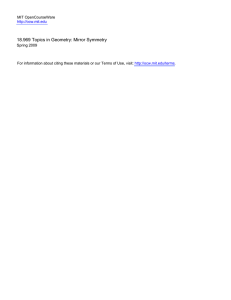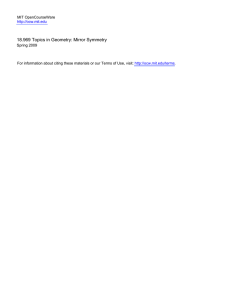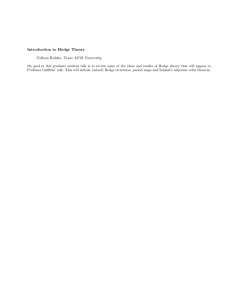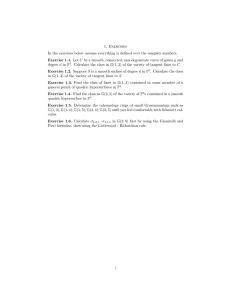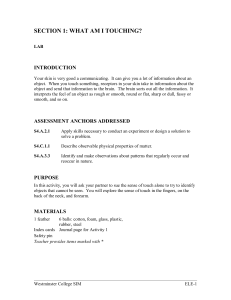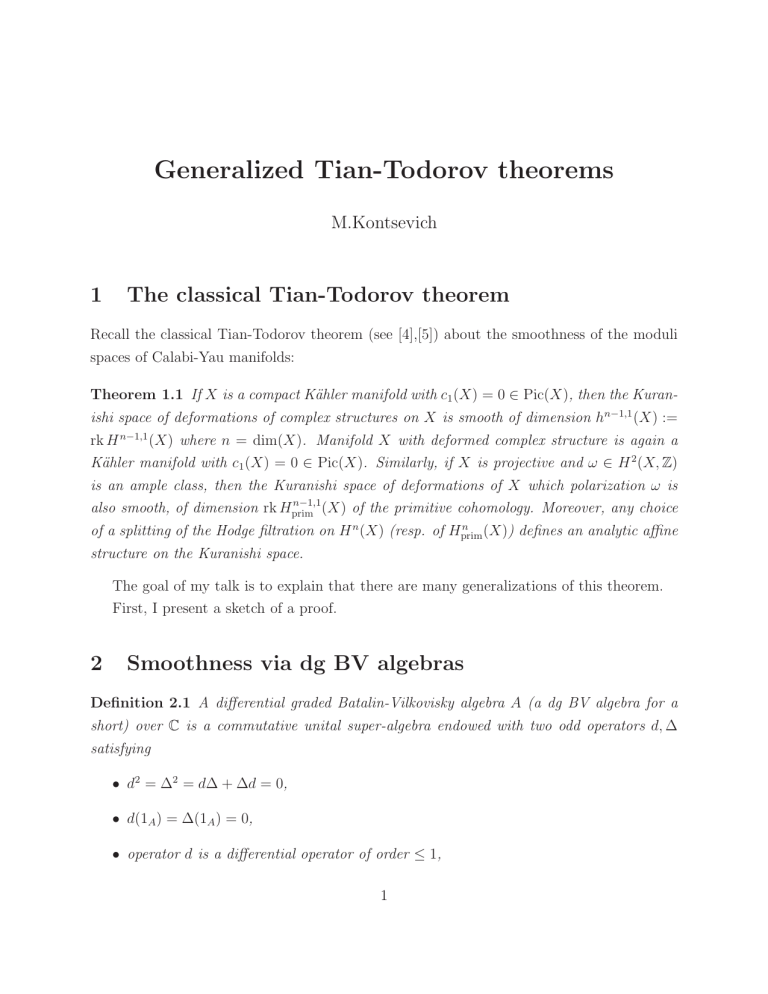
Generalized Tian-Todorov theorems M.Kontsevich 1 The classical Tian-Todorov theorem Recall the classical Tian-Todorov theorem (see [4],[5]) about the smoothness of the moduli spaces of Calabi-Yau manifolds: Theorem 1.1 If X is a compact Kähler manifold with c1 (X) = 0 ∈ Pic(X), then the Kuranishi space of deformations of complex structures on X is smooth of dimension hn−1,1 (X) := rk H n−1,1 (X) where n = dim(X). Manifold X with deformed complex structure is again a Kähler manifold with c1 (X) = 0 ∈ Pic(X). Similarly, if X is projective and ω ∈ H 2 (X, Z) is an ample class, then the Kuranishi space of deformations of X which polarization ω is n−1,1 also smooth, of dimension rk Hprim (X) of the primitive cohomology. Moreover, any choice n of a splitting of the Hodge filtration on H n (X) (resp. of Hprim (X)) defines an analytic affine structure on the Kuranishi space. The goal of my talk is to explain that there are many generalizations of this theorem. First, I present a sketch of a proof. 2 Smoothness via dg BV algebras Definition 2.1 A differential graded Batalin-Vilkovisky algebra A (a dg BV algebra for a short) over C is a commutative unital super-algebra endowed with two odd operators d, ∆ satisfying • d2 = ∆2 = d∆ + ∆d = 0, • d(1A ) = ∆(1A ) = 0, • operator d is a differential operator of order ≤ 1, 1 • operator ∆ is a differential operator of order ≤ 2. The vector space g := ΠA obtained from A by the changing of parity, carries a natural structure of Lie super-algebra: [a, b] = ∆(ab) − ∆(a)b − (−1)deg a a∆(b) . Operators d, ∆ on g are odd derivations with respect to the Lie bracket. Proposition 2.2 Let us assume that H • (A[[u]], d + u∆) is a free C[[u]]-module, where u is a formal even variable. Then the formal moduli space associated with dg Lie algebra (g, d) is smooth. Any trivialization of C[[u]]-module H • (A[[u]], d + u∆) gives a formal affine structure (“flat coordinates”) on the moduli space. The proof of the above proposition can be found e.g. in [3], (also see [1] for a slightly weaker result). The Tian-Todorov theorem follows from the Proposition, applied to AX := Γ(X, Ω0,• ⊗OX ∧• TX ) ¯ which is the algebra of ∂-forms on X with values in polyvector fields. The differential d is ¯ ∂, and the operator ∆ is the divergence with respect to the holomorphic volume form on X. The freeness property of the cohomology with respect to the deformed differential follows ¯ from the ∂ ∂-lemma. 3 Generalizations Instead of an individual Calabi-Yau manifold X we can consider: 1. a pair (X, D) where X is smooth projective variety (typically X is Fano), and D ⊂ X is a divisor with normal crossing such that [D] = −c1 (X) ∈ Pic(X), 2. a pair (X, D) where X is a Calabi-Yau manifold, c1 (X) = 0 ∈ Pic(X), and D ⊂ X is a divisor with normal crossings, 3. a triple (X, (Di )i∈I , (ai )i∈I ) where X is a smooth projective variety, (Di )i∈I is a finite collection of irreducible divisors whose union is a divisor with normal crossings, and (ai )i∈I is a collection of rational numbers 0 < ai < 1 ∀i ∈ I such that X ai [Di ] = −c1 (X) ∈ Pic(X) ⊗ Q i∈I 2 4. a pair (X, W ) where X is a smooth quasi-projective variety with c1 (X) = 0 ∈ Pic(X) and W : X → A1 is a proper map. 5. “broken Calabi-Yau variety” X, a singular projective scheme which is a reduced divisor with normal crossing in a larger smooth non-proper variety Y with c1 (Y ) = 0, given by X = WY−1 (0) where WY : Y → A1 is a proper map. All these examples can be merged together, i.e. one can consider broken non-compact X with a proper map to A1 and a fractional divisor with weights in [0, 1] ∩ Q representing −c1 (X) in Pic(X) ⊗ Q. The proof of the classical Tian-Todorov theorem presented in the previous section, extends immediately to all cases. The dg BV algebra in cases 1,2,3 is AX,D := Γ(X, Ω0,• ⊗OX ∧• TX,D ) where TX,D is the sheaf of holomorphic vector fields on X preserving D. The differential d is ¯ and operator ∆ is the divergence with respect to a (multi-valued) holomorphic given by ∂, volume form on X \ D. The contraction of these polyvector fields with the volume form ¯ gives the ∂-resolution of the sheaf of holomorphic forms on X which either have poles of first order on D (case 1), vanish on D (case 2), or take values in a local system with finite monodromy (case 3). The freeness property of cohomology follows from the theory of mixed Hodge structures. The mirror symmetry for Calabi-Yau manifolds generalizes to some of our examples. The case 1 with smooth D is dual to the case 4, e.g. X = CPn with a smooth anticanonical hypersurface D ⊂ X of degree n + 1, is mirror dual to (X ∨ , W ∨) where X ∨ is a partial compactification of Gnm endowed with a function W (x1 , . . . , xn ) = x1 + · · · + xn + 1 . x1 . . . xn Similarly, the case 2 with smooth D is dual to the case 5, e.g. the pair (X, D) where X is an elliptic curve and D ⊂ X is a collection of k points, it mirror dual to a singular elliptic curve X ∨ with double points, which is a wheel of k copies of CP1 . One of the corollaries of the mirror symmetry is that the mapping class group of the open surface X − D acts by automorphisms of D b (Coh(X ∨ )) (modulo powers of the shift functor). I do not know what are mirror partners for cases 1 and 2 with a non-smooth divisor D, and also for the case 3. 3 4 Non-compact Calabi-Yau manifolds Let X be a smooth projective manifold with a section of its anti-canonical bundle which vanish with multiplicities strictly > 1 at a divisor D ⊂ X with normal crossings. On the complement X \ D we have a non-vanishing holomorphic volume element Ω. We can define a dg BV algebra associated with X and Ω to be a subalgebra of AX,D consisting of such elements for which the contraction with Ω produces a form with logarithmic poles at D. Hence we obtain again certain smooth moduli spaces. Here is one important class of examples: let f = f (x, y) be polynomial defining a smooth curve in C2 . We associate with it a non-compact 3-dimensional Calabi-Yau manifold Y ⊂ C4 given by the equation uv = f (x, y) . One can show that Y can be represented as a complement X \ D of the type described above. Hence we obtain a smooth moduli space. E.g. for the case of hyperelliptic curve f (x, y) = y 2 + a0 + a1 x + · · · + a2g x2g + x2g+2 the universal family is obtained by variations of coefficients a0 , . . . , ag . The flat coordinates on the moduli space are associated with an appropriate splitting of the Hodge filtration, and are exactly those which appear in the matrix models, see e.g. [2]. 5 Speculations about Calabi-Yau motives The construction presented above gives many examples of variations of (mixed) Hodge structures of Calabi-Yau type over smooth bases. This leads to the following question, which I formulate for simplicity only in the pure case. Question 5.1 Let H be an absolutely indecomposable pure Hogde structure of weight w of algebro-geometric origin with coefficients in a number field (i.e. H is a direct summand of the cohomology space of some smooth projective variety), and such that there exists k ∈ Z such that H is of Calabi-Yau type, i.e. ′ ′ rk H k,w−k = 1, H k ,w−k = 0 ∀k ′ > k . Does there exists a smooth universal family of variations of H of an algebro-geometric origin, of dimension equal to rk H k−1,w−k+1? 4 There are many examples supporting this, e.g. one can take H to be the primitive part of the middle cohomology of hypersurface X ⊂ CPN −1 of degree d|N. The proof of the generalized Tian-Todorov theorems does not apply in this case, but still the dimension of the moduli space and of the corresponding Hodge component match. It would be wonderful if the answer to the question is positive. It means that we have nice smooth moduli stacks of Calabi-Yau motives (generalizations of Shimura varieties). With any pure Hodge structure H one can associate another Hodge structure of Calabi-Yau type (maybe decomposable), by taking the exterior power ∧m H where m ∈ Z+ is the dimension of a term F l H of the Hodge ′ ′ filtration of H, i.e. m = rk ⊕k′ ≥l H k ,w−k . In the case H = H 1 (C) where C is a smooth projective curve of genus g, the absolutely indecomposable summand H ′ of ∧g H containing the one-dimensional component ∧g H 1,0 , is a Hodge structure of Calabi-Yau type varying over an appropriate Shimura variety. One can check that the dimension of this variety always coincides with the corresponding Hodge number of H ′. References [1] S. Barannikov and M. Kontsevich, Frobenius manifolds and formality of Lie algebras of polyvector fields, Internat. Math. Res. Notices 1998, vol. 4, pp. 201–215. [2] R. Dijkgraaf and C. Vafa, On Geometry and Matrix Models, e-print hep-th/0207106. [3] L. Katzarkov, M. Kontsevich and T. Pantev, Hodge theoretic aspects of mirror symmetry, e-print 0806.0107. [4] G. Tian, Smoothness of the universal deformation space of compact Calabi-Yau manifolds and its Petersson-Weil metric, Mathematical aspects of string theory (San Diego, Calif., 1986), World Sci. Publishing, Singapore, 1987, Adv. Ser. Math. Phys., vol. 1, pp. 629–646 [5] A Todorov, The Weil-Petersson geometry of the moduli space of SU(n ≥ 3) (CalabiYau) manifolds. I, Comm. Math. Phys., 1989, vol. 126, pp. 325–346 Maxim Kontsevich, IHES, 35 route de Chartres, Bures-sur-Yvette 91440, France, e-mail: maxim@ihes.fr 5
